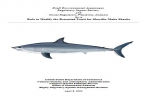Cookiecutter shark bite patterns on pelagic fishes
Cookiecutter shark (Isistius spp.) bite patterns on pelagic fishes in aggregated schools in the western equatorial Atlantic Ocean Rafael Menezes, João Paulo Dantas Marinho, Grazielly Campos de Mesquita, Guelson Batista da Silva ABSTRACT: Cookiecutter sharks are pelagic ectoparasites that feed on pieces of flesh from large marine animals. Knowledge on these sharks is still rather
Mitochondrial DNA Reveals Small-scale Population Structure in the California Horn Shark
Little Sharks in a Big World: Mitochondrial DNA Reveals Small-scale Population Structure in the California Horn Shark (Heterodontus francisci) Sean J Canfield, Felipe Galván-Magaña, Brian W Bowen ABSTRACT: The California horn shark (Heterodontus francisci) is a small demersal species distributed from southern California and the Channel Islands to Baja California and the Gulf of California.
Global shark species richness is more constrained by energy than evolutionary history
Global shark species richness is more constrained by energy than evolutionary history Emmaline R. Sheahan, Gavin J.P. Naylor, Daniel J. McGlinn ABSTRACT: Aim To examine the support of two ecological diversity theories- The Ecological Limits Hypothesis (ELH) and the Niche Conservatism Hypothesis (NCH) – in explaining patterns of global shark diversity. Location Global scale and
Heterodonty and ontogenetic shift dynamics in the dentition of the tiger shark
Heterodonty and ontogenetic shift dynamics in the dentition of the tiger shark Galeocerdo cuvier (Chondrichthyes, Galeocerdidae) Julia Türtscher, Patrick L. Jambura, Faviel A. López-Romero, René Kindlimann, Keiichi Sato, Taketeru Tomita, Jürgen Kriwet ABSTRACT: The lifelong tooth replacement in elasmobranch fishes (sharks, rays and skates) has led to the assemblage of a great number of teeth
Elasmobranch diversity across a remote coral reef atoll
Elasmobranch diversity across a remote coral reef atoll revealed through environmental DNA metabarcoding Nicholas Dunn, Vincent Savolainen, Sam Weber, Samantha Andrzejaczek, Chris Carbone, David Curnick ABSTRACT: As elasmobranchs are becoming increasingly threatened, efficient methods for monitoring the distribution and diversity of elasmobranch populations are required. Environmental DNA (eDNA) metabarcoding is a progressively applied technique that
Three complete mitochondrial genomes of shortfin mako sharks
Three complete mitochondrial genomes of shortfin mako sharks, Isurus oxyrinchus, from the Atlantic and Pacific Oceans Marissa R. Mehlrose, Andrea M. Bernard, Kimberly A. Finnegan, Lauren E. Krausfeldt, Jose V. Lopez & Mahmood S. Shivji ABSTRACT: We present complete mitogenome sequences of three shortfin mako sharks (Isurus oxyrinchus) sampled from the western Pacific, and eastern
Bycatch of a Critically Endangered Shark Glyphis glyphis in a Crab Pot Fishery
Bycatch of a Critically Endangered Shark Glyphis glyphis in a Crab Pot Fishery: Implications for Management Richard D. Pillans, Gary C. Fry, Geoff D. Carlin, Toby A. Patterson ABSTRACT: The speartooth shark Glyphis glyphis is a Critically Endangered whaler shark known from a few tropical river systems in northern Australia and Papua New Guinea. There
Effects of shark tourism on the yellowtail kingfish
Effects of shark tourism on the daily residency and movements of a non-focal pelagic teleost Thomas M. Clarke, Sasha K. Whitmarsh, Ross G. Dwyer, Vinay Udyawer, Hugh Pederson, Charlie Huveneers ABSTRACT: Marine wildlife tourism is increasing in popularity, with operations targeting a wide range of taxa globally. While previous studies have mostly focused on assessing
Unreported discards of internationally protected pelagic sharks
Unreported discards of internationally protected pelagic sharks in a global fishing hotspot are potentially large Gonzalo Mucientes, Marisa Vedor, David W. Sims, Nuno Queiroz ABSTRACT: Global abundances of oceanic pelagic sharks have declined due to overfishing. Internationally protected shark species remain at risk due to indiscriminate bycatch in longline fisheries with under-reported catches affecting reliability
Field metabolic rate and prey consumption rate of the Greenland shark
Life in the slow lane: field metabolic rate and prey consumption rate of the Greenland shark (Somniosus microcephalus) modelled using archival biologgers Eric Ste-Marie, Yuuki Y. Watanabe, Jayson M. Semmens, Marianne Marcoux, Nigel E. Hussey ABSTRACT: Field metabolic rate (FMR) is a holistic measure of metabolism representing the routine energy utilization of a species living
Proposed Changes to Atlantic Shortfin Mako Shark Retention Limits
Draft Environmental Assessment,Regulatory Impact Review, and Initial Regulatory Flexibility Analysis for a Rule to Modify the Retention Limit for Shortfin Mako Sharks United States Department of CommerceNational Oceanic and Atmospheric AdministrationNational Marine Fisheries ServiceOffice of Sustainable FisheriesHighly Migratory Species Management Division April 8, 2022 ABSTRACT: This proposed action is necessary to implement bindingrecommendations of the
Shark habituation to a food-related olfactory cue
Shark habituation to a food-related olfactory cue Dennis D.U. Heinrich, Charlie Huveneers, Thomas M. Houslay, Félicie Dhellemmes, Culum Brown ABSTRACT: Learning is a process that allows animals to develop adaptive behavioural responses to novel situations within an individual’s lifetime. The simplest form of learning, habituation, acts a fundamental filter mechanism, which allows animals to ignore
Estimated life-history traits and movements of the Caribbean reef shark in The Bahamas
Estimated life-history traits and movements of the Caribbean reef shark (Carcharhinus perezi) in The Bahamas based on tag-recapture data Brendan S. Talwar, Darcy Bradley, Christopher Berry, Mark E. Bond, Ian A. Bouyoucos, Annabelle M. L. Brooks, Candace Y. A. Fields, Austin J. Gallagher, Tristan L. Guttridge, Annie E. Guttridge, Neil Hammerschlag, Ian Hamilton, Bryan A.
A biologging database of juvenile white sharks from the northeast Pacific
A biologging database of juvenile white sharks from the northeast Pacific O’Sullivan, J., Lowe, C.G., Sosa-Nishizaki, O. et al. ABSTRACT: Species occurrence records are vital data streams in marine conservation with a wide range of important applications. From 2001–2020, the Monterey Bay Aquarium led an international research collaboration to understand the life cycle, ecology, and
Framing Effects on Attitudes and Intentions Toward Shark Meat Consumption in Lima, Peru
Framing Effects on Attitudes and Intentions Toward Shark Meat Consumption in Lima, Peru Daniella Biffi, Adam S. Richards, Molly Weinburgh ABSTRACT: Peru has one of the major shark fisheries in the world. Moreover, shark meat consumption is popular and the main commercially exploited species are considered threatened. Recent studies have found high mislabeling rates and




